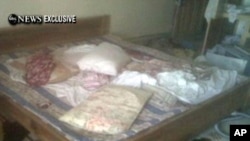When American commandos left the compound where Osama bin Laden was hiding in Pakistan, they took what a senior U.S. intelligence official calls "a robust collection of materials" that is expected to yield a trove of information about the al-Qaida terrorist network.
While U.S. military Special Forces troops systematically worked their way through the compound, finding and killing bin Laden and his associates, other members of the team were collecting everything they could that might contain useful information.
President Barack Obama’s chief counterterrorism adviser John Brennan talked about that part of the operation at a White House briefing on Monday.
"The people who were on the compound took advantage of their time there to make sure that we were able to acquire whatever material we thought was appropriate and what was needed. And we are in the process right now of looking at whatever might have been picked up," Brennan said.
Raw footage of the compound where Osama bin Laden was killed:
A senior intelligence official, who spoke to reporters on condition of anonymity, said the Central Intelligence Agency has set up a team to analyze the material in the hope it will lead to other al-Qaida members.
A former top U.S. counterintelligence official, Marion Bowman, knows what he would have been looking for if he had been on the team.
"I’d be looking for pocket litter. I’d be looking for anything which would have DNA on it. I’d be looking for any scraps of paper which would indicate how he is communicating, basically, information that would indicate who he is in communication with, who has been there to get an idea of what kind of network he is still managing or a part of," Bowman said.
Bowman was a U.S. Navy intelligence officer and a Federal Bureau of Investigation official before becoming former President George W. Bush’s number two counterintelligence adviser in 2006. He has some insight into what kind of team the CIA has likely put together to look at the bin Laden material
"Well, at the very least you’re going to have forensic specialists in computer technology. But in addition to that you’re probably going to have what law enforcement would call ‘evidence response teams,’ people who are going to be looking for the little bits and pieces that might be around," he said.
And Bowman adds that the team will need translators, perhaps for several languages, and also people who know the Arab, Afghan and Pakistani cultures, to be sure they don’t miss any subtle clues about bin Laden’s activities and contacts.
Officials will not say exactly what the commando team collected, but several news organizations are reporting the material includes a large number of computers, hard disc drives and various other computer memory devices.
Counterterrorism adviser John Brennan says when it comes to this kind of material "it’s not necessarily quantity, frequently it’s quality" that is important. Officials hope the quality of the information from Osama bin Laden’s home will prove to be high. On Tuesday, White House Press Secretary Jay Carney discussed what they hope to learn.
"First of all and most importantly, in any case, is any evidence of planned attacks. Second, would be information that could lead to other high value targets or other networks that exist that we don’t know about, or that we only know a little about. And then third, more broadly, on the al-Qaida network itself and then the sustaining network for bin Laden in Pakistan, what allowed him to live in that compound for as long as he did," Carney said.
Carney says President Obama’s goal remains to "disrupt, dismantle and defeat" al-Qaida. And the president’s counterterrorism adviser John Brennan said Monday’s operation will not end that effort, but rather the information gathered from the compound will be an important part of continuing it.
"We feel as though this is a very important time to continue to prosecute this effort against al Qaeda, take advantage of the success of yesterday and to continue to work to break the back of al Qaeda," he said.
This phase of the effort will involve the same type of what Brennan called "exceptionally tedious and painstaking" analysis work, over several years, that led officials to one of bin Laden’s couriers and eventually to the terrorist leader himself.
"Over time we were able to piece together additional information, get the name he was known by, his nom de guerre, associate that then eventually with his real name, associate that then with other things that that real name was associated with, and track it until we got to the compound in Abbottabad," he said.
Former Bush administration official Marion Bowman says the information gathered Monday could shorten the investigation process for some al-Qaida operatives, but he says it will also likely spark new and lengthy lines of inquiry.
"I’d like to be able to say that it may shorten the process. But I think I’d be more comfortable saying that it’s going to start a process of finding people that they’re not sure of [exactly who they are], or where they’ve been living," Bowman said.
Officials hope the information will provide solid leads that help them hit hard at al-Qaida’s network. But Bowman acknowledges that bin Laden’s contacts are likely already on the run and working hard to cover their tracks, meaning that what one official called the "relentless" work that netted the world’s most wanted terrorist will continue for some time to come.








